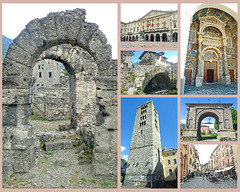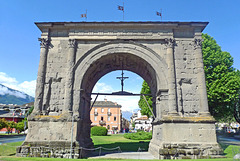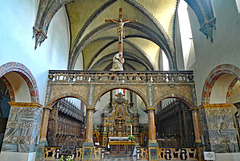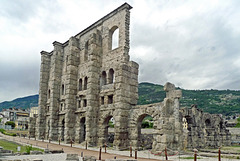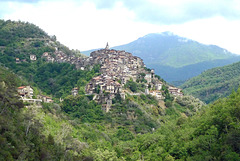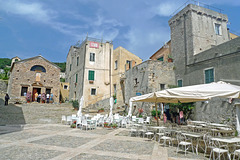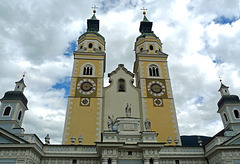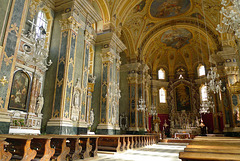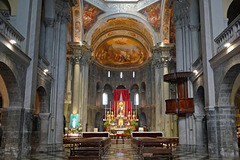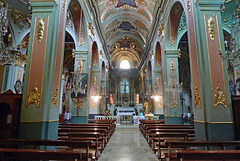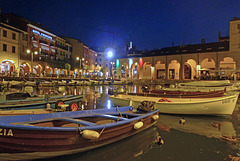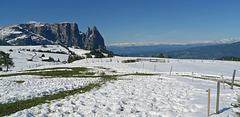
Italia - Italy - Italië
Italy - Aosta
| |
|
|
|
Aosta is the capital of the Aosta Valley, located at the confluence of the rivers Buthier and Dora Baltea. It was a stronghold of the Salassi, a Celtic tribe that was subdued by the Romans in 25 BC. Augusta Praetoria - a Roman town - was founded there by Emperor Augustus. Aosta was always the most important centre of the Valle d’Aosta and became the regional capital in 1945.
Aosta retains the walls, two gates, and the street plan of its Roman predecessor, as well as a triumphal arch in honour of Augustus and remains of the theatre and the amphitheatre. The rectangular street plan, laid out in equal blocks, is an outstanding example of Roman formal city planning. Of later monuments, the cathedral is notable for its treasury and 12th-century floor mosaics, and the collegiate church of S. Orso for its Romanesque cloisters and Gothic choir stalls.
Italy - Aosta, Arco di Augusto
| |
|
|
|
The Arco di Augusto (Arch of Augustus) was erected in 25 BC on the occasion of the victory of Rome over the Gallic tribe, calles the Salassi and founding the new colony.
The arch has a single vault, with a height to the keystone of 11,4 meters. Its span is a barrel vault, constituting an extension in width of a round arch, measuring 8,3 meters. The monument, which changed during centuries, consists of a single round arch framed by half-columns and surmounted by Corinthian capitals and crowned by a Doric trabeation.
The arch's modern appearance is the result of a final intervention for restoration and consolidation which occurred in 1912. The wooden crucifix displayed below the vault is a copy of the one which was placed there in 1449 as a votive offering against the flooding of the river Buthier, which flows a little to the east.
Emperor Augustus name adorns not just the arch, but also the region itself: "Aosta" is a derivative of Augustus.
Italy - Aosta, Cattedrale di Santa Maria Assunta e…
| |
|
|
|
The Cathedral of Santa Maria Assunta e San Giovanni Battista (Cathedral of the Assumption of Mary and Saint John the Baptist) is the most important and oldest religious building in Aosta. The church was founded at the end of the 4th century, when a Roman complex was converted into a Christian place of worship.
At the end of the 15th century and the beginning of the 16th century, a series of works on the body of the building gave it the appearance it still has today, such as the Renaissance-style façade built between 1522 and 1526, decorated with frescoes and terracotta sculptures.
The ïmpressive original structure of the cathedral was modified in the 11th century. The cathedral is rich in art and religious treasures: a precious cycle of 11th-century frescoes that decorate the vault was discovered in 1979, while the interior of the cathedral houses, among other things, a wooden crucifix from 1397, valuable artistic stained glass windows made between 1400 and 1500. The high choir, dominated by a crucifix of the fourteenth century, has thirty wooden stalls dating from 1469.
The building dominates the city thanks to its two bell towers, which with 60 meters in height are the tallest buildings in the entire Aosta Valley.
Italy - Aosta, Collegiata di Sant'Orso
| |
|
|
|
The Collegiata di Sant'Orso (Collegiate church of Saint Ursus) is dedicated to Saint Ursus of Aosta. The original church - dating back to the 5th century - had a single hall. It was entirely rebuilt in the 11th century, during the Carolingian age. Later the church was further renovated into a basilica plan with three naves with wooden trusses. These were replaced by Gothic cross vaults in the 15th century.
The church has a quite simple interior with 11th century Ottonial frescoes and a wooden choir. It is also home to numerous missals and reliquaries, including the relics of Saint Ursus, which rest in the crypt.
The Romanesque cloister (PiP3) is another religious building in the Saint Ursus complex. Its construction dates back to the 12th century. The cloister has historiated capitals (PiP4), decorated with fantastic beasts, biblical events and scenes from the life of Saint Ursus himself. 37 of the 42 original capital remains: they were originally in white marble, though now they mostly appear in dark gray color after being washed with ash paint.
Opposite the entrance of the collegiate church stands the imposing bell tower (PiP5), 46 meters tall. Originally it was a defense tower dating back to the end of the 10th century. The present structure, in Romanesque style, dates to the 12th century
Italy - Aosta, Teatro Romano
| |
|
|
|
Teatro Romano (Roman Theatre) was built in the late reign of Roman emperor Augustus, some decades after the foundation of the city (25 BC). It was extended two centuries later. The theatre occupies three blocks annexed to the ancient city walls, along the Roman main road structure occupied an area of 81 by 64 meters. One can still identify its semi-circular tiers, the orchestra pit, and the stage wall, which was once raised with decorated columns, marble and statues. The theatre could hold as many as 4.000 spectators.
Today the southern façade - perforated by arches and windows - still remains. The wall has a height of 22 meters. The cavea was enclosed in a rectangular-shaped wall including the remaining southern part. This was reinforced by buttresses each 5.5 metres from the other, and included by four orders of arcades which lightened its structure.
In the Middle Ages, the original function of the theater was forgotten and different constructions began to grow around it. Their demolition was proposed in 1863 , but the process finally completed between 1933 and 1941.
Italy - Apricale
| |
|
|
|
The first written documents about Apricale date back to 1267. The history of Apricale, however, officially begins about two centuries before with the foundation of the castle, wanted by the accounts of Ventimiglia. The place, chosen as a defensive outpost, is called Apricus; around the castle the village develops.
In 1270 Apricale entered the fiefdom of the Doria of Dolceacqua, passing definitively into the sphere of influence of the Republic of Genoa. In the 18th century, Genoa’s difficulties are reflected in Apricale: wars and economic crisis, but also frosts, droughts and famines make it the darkest century in the history of the village, until the French occupation in 1794. In 1815, according to the dictates of the Congress of Vienna, it became part of the kingdom of Sardinia.
Apricale comes from “apricus”, which in Latin means “exposed to the sun”, and in fact, the village is all built on the southern side of the hill. Coming from the Nervia Valley the village seems to be a waterfall of houses surrounded by forested hills. The little mountain village itself is a labyrinth of houses and alleyways.
Italy - Apricale, Chiesa della Purificazione di Ma…
| |
|
|
|
The Chiesa della Purificazione di Maria Vergine (Church of the Purification of the Virgin Mary) is the parish church of Apricale. The church - built in the 13th century - is located in the heart of the centre of the perched medieval village.
The church was restored several times and today it appears in baroque style with a neo-Romanesque façade. The interior is composed of three naves divided in two rows of four pillars each. Inside the vaults, in 1904, painter Leonida Martini frescoed floral patterns and images of saints.
The bell tower of the church is remarkable with a bicycle facing upwards. This contemporary artwork of Sergio Bianco symbolizes the power of non-gravity. I must admit that I had not seen the artwork during my visit. But a photo of Nora Caracci pointed me to this unusual tower.
Italy - Borgio Verezzi
| |
|
|
|
Borgio Verezzi is a little village on the Riviera di Ponente, which has two distinct areas: a beach resort along the coast of the Mediterranean Sea called Borgio and the medieval village of Verezzi in the hinterland on a hill. There are actually four separate hamlets that make up Verezzi: Crosa, Piazza, Poggio, and Roccaro.
The centre of the medieval village of Verezzi is Piazzetta Sant'Agostino, surrounded by ancient buildings and the 14th century Church of Sant'Agostino.
Borgio Verezzi is listed as one of the most beautiful villages in Italy ( il borghi pui bella d'Italia ).
During our visit, a wedding ceremony took place in the small church, so we could not take a look inside.
Italy - Brixen Cathedral
| |
|
|
|
The ‘Dom Mariae Aufnahme in den Himmel und St. Kassian’ (Cathedral of Santa Maria Assunta and San Cassiano) is the largest church in Brixen, once belonging to the powerful Principality of Brixen, nowadays the diocese of Bolzano-Brixen. Although Bolzano is currently the city of residence of the bishop, the most important church in South Tyrol is still the cathedral in Brixen.
The cathedral is dating back to the late 10th century when the main building and its annexes were erected. A fire destroyed the church in 1174. The new Romanesque-gothic building was rebuilt in the baroque style during the period of 1745 to 1755.
The cathedral’s two towers are the landmark of the city of Brixen. The interior of the cathedral is a masterpiece of historical and artistic value. Its wide domed nave is decorated with rich marble and stucco. The main altar has a very striking altarpiece, but the decorative highlight is the fresco on the ceiling.
Italy - Brixen Cathedral
| |
|
|
|
The ‘Dom Mariae Aufnahme in den Himmel und St. Kassian’ (Cathedral of Santa Maria Assunta and San Cassiano) is the largest church in Brixen, once belonging to the powerful Principality of Brixen, nowadays the diocese of Bolzano-Brixen. Although Bolzano is currently the city of residence of the bishop, the most important church in South Tyrol is still the cathedral in Brixen.
The cathedral is dating back to the late 10th century when the main building and its annexes were erected. A fire destroyed the church in 1174. The new romanesque-gothic building was rebuilt in the baroque style during the period of 1745 to 1755.
The cathedral’s two towers (PiP 1) are the landmark of the city of Brixen. The interior of the cathedral is a masterpiece of historical and artistic value. Its wide domed nave is decorated with rich marble and stucco (PiP 2). The main altar has a very striking altarpiece (PiP 3), but the decorative highlight is the fresco on the ceiling.
Italy - Como, Basilica di San Fedele
| |
|
|
|
The Basilica di San Fedele - the ancient cathedral of Como - was probably built in 1120 on the ruins of a previous building. The construction was finished years later. Along the centuries the original Romanesque setup of the building was largely modified. In the 17th century the main nave changed into a barrel vault ceiling and side apsides were modified in the 16th century when some arcs were closed and replaced with paintings and stuccos. In 1805 the octagonal lantern was moved up. Between 1807 and 1808 the side chapels were built. Also, the church was restored in the beginning of the 21st century, especially the façade and the tower bell.
I have seen many churches all over the world and consider the interior of the San Fedele as one of the most beautiful. I visited the church in 'corona time', because a mouth mask was still obligatory - which I did not have with me - it unfortunately remained a very short visit with hardly any time to take pictures.
Italy - Corniglia
| |
|
|
|
The Cinque Terre is a string of five old fishing villages perched high on the rugged coastline of the east end of the Italian Riviera in Liguria. Until recently they were linked only by mule tracks and accessible only by rail or water. Nowadays Cinque Terre is a UNESCO Heritage Site. It's also one of the most sought-after travel destinations in all of Italy. The five villages are no longer the isolated hamlets they once were, but there’s still a feeling of authenticity, with few roads and perfectly preserved architecture.
Corniglia is the central village and also the smallest of the Cinque Terre. It is unique compared to the other villages for its position, as it is built on top of a cliff 100 meters above the Mediterranean Sea. That makes the village known as the “Balcony of the Cinque Terre”. N ext to that Corniglia is special because it is the only village of the Cinque Terre where you are not immediately in the middle of the village when you get off the train. Therefore it is a village that many tourists skip.
Artifacts found in Pompeii, have historians dating the origins of Corniglia all the way back to the Roman Age. Markings on terracotta containers have helped them deduce even the origins of the name: the words “Gens Cornelia”, which translates into “from the (Roman) family Cornelia”. It is thought that Coniglia was probably a colony of slaves who took on the name Corenila, from the slaveholder who gave them their freedom.
Corniglia has a long and rich agricultural tradition. The village is surrounded on three sides by vineyards and terraces. Its architecture is closer to that of a rural inland village than that of a coastal village.
Italy - Corniglia, Chiesa di San Pietro
| |
|
|
|
The Chiesa di San Pietro (St. Peter Church) was built between 1334 and 1351 and has a very sober sandstone façade. The wonderful white Carrara marble rose window has a very elaborate shape, with all different designs and, in the central hole, a deer symbol of the village. The cornice is “saw-toothed”, with hanging arches, some of which are decorated with animal heads.
The parish church - with both Gothic and Baroque style characteristics – is one of the most interesting monument of Corniglia and Cinque Terre. The interior - with a basilica plan with three naves - underwent some interventions in the Baroque style. It offers a finely crafted altarpiece and 18th-century paintings.
Italy - Dolceacqua
| |
|
|
|
Dolceacqua (“sweet water”) is situated inland about 10 km from the Ligurian coast along the Nervia river. The town was first mentioned in the year of 1151, when counts from Ventimiglia started the construction of a castle in the hills. The castle was further expanded along with the village in the next centuries.
Dolceacqua is divided into two areas by the river Nervia: the old village known as Terra and Borgo which developed later. The 15th century Ponte Vecchio spans the river and connects the two sections of the village. (Claude Monet visited here twice \and the bridge and village were the subjects of his paintings).
Doria Castle towers high above the maze of narrow streets and alleys of Terra . The Dorias were the last and most famous ruling family of the area. The castle was of course used for defense and to monitor the goings-on of the valley as well as being used as a hideout. It has recently undergone reconstruction since it was in a state of almost complete abandonment.
Italy - Dolceacqua, Chiesa di Sant’Antonio Abate
| |
|
|
|
The Chiesa Parrocchiale di Sant’ Antonio Abate (Parish Church of Sant'Antonio Abbot) in Dolceacqua is dating back to the 15th century. Very little remains of its original appearance, as it has undergone numerous interventions over the centuries. Until 1800 it was encompassed by civil buildings. The bell tower was built in 1621, using the watchtower of the city walls.
The church was later renovated in baroque style and is adorned with rich interior decorations and numerous works of art. Among other things it houses the important polyptych of Santa Devota
Italy - Desenzano del Garda
| |
|
|
|
Desenzano - located on the south-western shore of Lake Garda - was already in the past a favourite vacation spot for the élite from Verona. And today it is till a popular Italian holiday destination, which attracts myriad tourists from everywhere in Europe.
The peaceful ‘Porto Vecchio (Old Harbour) - already mentioned in 1274 - was expanded in the current configuration at the time of the Venetian Republic in service of the flourishing grain market. The ancient dock overlooks Palazzo Todeschini, with its arches it is dating back to the end of the 16th century.
Nowadays little boats are moored in the harbour, which is lined with several cafes, bars and restaurants. The well restored business houses along the ‘Porto Vecchio’ are reminders of a glorious past of Desenzano del Garda.
Italy - Dolomites, Schlern
| |
|
|
|
The Schlern (Monte Sciliar) is one of the most well known landmarks of the Dolomites and South Tyrol. It is famous due to its location as westernmost bastion of the Dolomites and the two peaks - Santner Spitze and Euringer Spitze - in front of the mountain massif.
The Schlern has a height of 2.563 meters and is a long stretched plateau, which drops vertically on almost all sides. Its unique location and characteristic profile makes it a very recognizable mountain.
I took this image late September from the Seiseralm, most probably after the first snowfall in the Dolomites.
Italy - Dolomites, Langkofel and Plattkofel
| |
|
|
|
Langkofel/Sassolungo (left) and Plattkofel/Sassopiatto (right) seen from the Goldknopfsee (Lake Goldknopf), nearby the Edelweißhütte. The amazing peaks of 3.181 m. and 2.969 m. are towering above the Seiseralm.
The Goldknopsee is an artificial lake, which was constructed in 2003, storing water to feed snowmaking equipment and is also intended as a water reservoir for possible fires.
I made this image late September from the Seiseralm, most probably after the first snowfall in the Dolomites.
Jump to top
RSS feed- Latest items - Subscribe to the latest items added to this album
- ipernity © 2007-2024
- Help & Contact
|
Club news
|
About ipernity
|
History |
ipernity Club & Prices |
Guide of good conduct
Donate | Group guidelines | Privacy policy | Terms of use | Statutes | In memoria -
Facebook
Twitter

